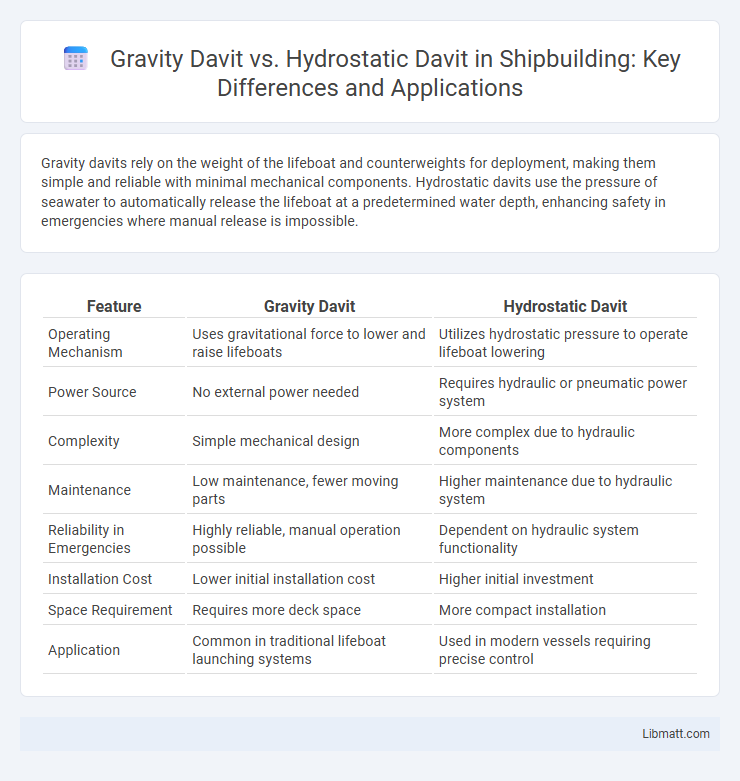Gravity davits rely on the weight of the lifeboat and counterweights for deployment, making them simple and reliable with minimal mechanical components. Hydrostatic davits use the pressure of seawater to automatically release the lifeboat at a predetermined water depth, enhancing safety in emergencies where manual release is impossible.
Table of Comparison
| Feature | Gravity Davit | Hydrostatic Davit |
|---|---|---|
| Operating Mechanism | Uses gravitational force to lower and raise lifeboats | Utilizes hydrostatic pressure to operate lifeboat lowering |
| Power Source | No external power needed | Requires hydraulic or pneumatic power system |
| Complexity | Simple mechanical design | More complex due to hydraulic components |
| Maintenance | Low maintenance, fewer moving parts | Higher maintenance due to hydraulic system |
| Reliability in Emergencies | Highly reliable, manual operation possible | Dependent on hydraulic system functionality |
| Installation Cost | Lower initial installation cost | Higher initial investment |
| Space Requirement | Requires more deck space | More compact installation |
| Application | Common in traditional lifeboat launching systems | Used in modern vessels requiring precise control |
Introduction to Lifeboat Davit Systems
Gravity davit systems utilize the natural force of gravity to lower lifeboats smoothly and safely into the water, ensuring reliable deployment even in emergency situations. Hydrostatic davit systems rely on hydraulic power to control the movement and positioning of lifeboats, offering precise and controlled launching capabilities ideal for larger vessels. Both systems are critical components of maritime safety equipment designed to facilitate efficient evacuation during emergencies.
What is a Gravity Davit?
A Gravity Davit is a lifting device designed to rely on its own weight for stability and operation, often used for lowering and raising lifeboats or small boats safely from ships or docks. It operates without the need for complex mechanical or hydraulic power sources, making it simple, reliable, and cost-effective. Your choice of a Gravity Davit can ensure ease of use with minimal maintenance compared to hydrostatic davits, which depend on fluid pressure systems for movement.
What is a Hydrostatic Davit?
A hydrostatic davit is a marine lifting device designed to deploy and retrieve lifeboats using water pressure as a power source, offering smooth and controlled operation. Unlike gravity davits, which rely on the weight of the lifeboat for lowering, hydrostatic davits use hydraulic or pneumatic systems powered by the vessel's water pressure to manage lifeboat movements. These davits are favored for their precision handling and ability to operate in various sea conditions, enhancing safety during emergency evacuations.
Key Differences Between Gravity and Hydrostatic Davits
Gravity davits rely on counterweights to balance and lower loads smoothly, requiring minimal external power, while hydrostatic davits use hydraulic systems to control load movement with precise pressure adjustments. The key differences center on their operating mechanisms: gravity davits leverage mechanical advantage through gravitational force, making them ideal for simplicity and reliability in emergencies, whereas hydrostatic davits offer enhanced control and flexibility, suitable for complex or heavy lifting tasks. Understanding these distinctions helps you choose the right davit system based on operational needs, maintenance requirements, and safety considerations.
Advantages of Gravity Davit Systems
Gravity davit systems offer simplicity and reliability by using counterweights to balance loads, eliminating the need for complex hydraulic components and reducing maintenance costs. These systems provide smooth, controlled operation, enhancing safety during lifeboat deployment or cargo handling in marine environments. You benefit from durability and operational efficiency, especially in harsh conditions where hydraulic davits may be prone to failure.
Advantages of Hydrostatic Davit Systems
Hydrostatic davit systems offer precise load control and smooth lowering capabilities, reducing the risk of equipment damage and enhancing operational safety. These systems require minimal manual effort due to their automated balancing mechanism, which improves efficiency and reliability in maritime lifting operations. Hydrostatic davits also provide superior performance in rough sea conditions, maintaining stability and control where gravity davits might struggle.
Installation and Maintenance Considerations
Gravity davits require simpler installation as they rely on counterweights and minimal mechanical components, reducing the need for complex rigging and specialized foundations. Hydrostatic davits demand more precise installation due to hydraulic systems and pressure controls, necessitating trained technicians for calibration and safety checks. Maintenance for gravity davits is generally lower-cost and less frequent, while hydrostatic davits require regular inspections, fluid replacements, and component servicing to ensure hydraulic integrity and operational reliability.
Safety Features of Gravity vs Hydrostatic Davits
Gravity davits provide safety through a simple, mechanical lowering system that relies on counterweights, minimizing the risk of power failure during lifeboat deployment. Hydrostatic davits incorporate hydraulic pressure controls, offering precise and smooth operation with built-in overload protection to prevent accidental release or sudden drops. Both systems are designed to meet stringent international safety standards, but hydrostatic davits often include advanced monitoring sensors for real-time feedback and emergency stop functions.
Cost Comparison and Efficiency
Gravity davits generally offer lower upfront costs and reduced maintenance expenses compared to hydrostatic davits, making them a cost-effective choice for many maritime applications. Hydrostatic davits, while more expensive initially, provide higher operational efficiency through automated mechanisms that enhance safety and speed during deployment and recovery. Your choice depends on balancing budget constraints with the need for reliable, efficient performance in demanding marine environments.
Choosing the Right Davit System for Your Vessel
Choosing the right davit system for your vessel depends on operational needs, load capacity, and safety requirements. Gravity davits offer simplicity and reliability with manual operation, ideal for smaller vessels or lifeboat deployment in calm conditions, while hydrostatic davits provide automated, powered control suitable for larger vessels requiring precise handling and rapid deployment in rough seas. Assess your vessel's size, crew expertise, and emergency protocols to ensure your davit system enhances safety and performance effectively.
Gravity davit vs hydrostatic davit Infographic

 libmatt.com
libmatt.com